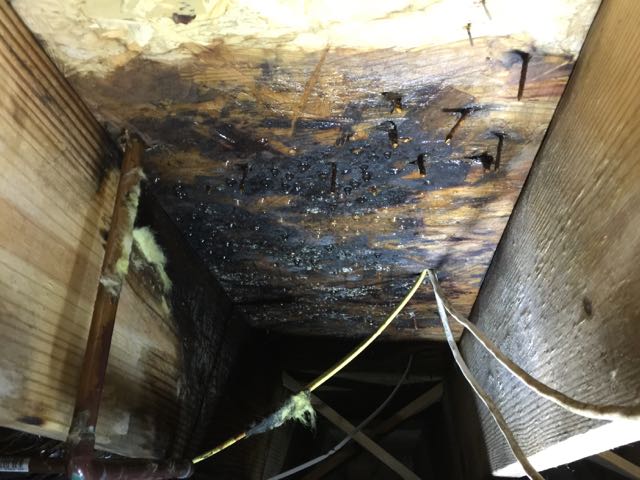Mold is everywhere. There are a great many different kinds of mold in this world. Each mold has its own unique characteristics, and some can even represent a danger to the health of humans and animals. It is worth noting that the world has more than 100 types of mold. Some of these molds have been known to cause sometimes serious illness. Another noteworthy fact is that the CDC does not have enough research to back up all of the many claims against mold.
Some professionals in the medical feel strongly about the effects of mold, but in some cases, there is little empirical evidence to back up those concerns. Regardless of whether a particular mold is harmful or not, it’s good to take efforts to prevent mold from growing in your home, and to remove it if it has already become established.
Top 5 Mold Species Found in Homes
Without further ado, here are the top 5 molds often found in homes.
Number 5 on the list is…
5) ASPERGILIUS
According to an Aspergilius website, the fungus is quite common in homes. It is possible and even likely that you are breathing some aspergilius right now without even being aware of it! Rest easy, however, because in most cases the fungus is thought to be harmless to healthy individuals. On the other hand, individuals who suffer from weak immune systems can get sick from breathing aspergilius. Some of the maladies that can be caused by breathing the fungus are: sinus irritation, allergic reactions, and acute or chronic infections of the lungs. Aspergilius can be found in air conditioning systems, indoor air as well as outdoor air. The CDC has stated that it is impossible to avoid aspergilius and most people breathe it without consequence. Unless you have tuberculosis or a weak immune system, you most likely have nothing to worry from aspergilius.
4) ALTERNARIA
Next up is a mold called alternaria. The Missouri School Of Medicine states that Alternaria is “..the most important allergenic molds found in the US.” In other words, alternaria can cause allergy problems for people. In fact, 70% of people who get allergies are affected by Alternaria! Alternaria usually resides in outdoor air. And it’s more common than you might think. You know the tiny black spots you sometimes see on the tomatoes you buy from the supermarket? More often than not it is alternaria. Symptoms of Alternaria allergies are coughing, wheezing, sneezing, and other breathing problems.
3) CLADOSPORIUM
Now for a real baddie: cladosporium — a much more potent fungus that can cause some serious health issues. Check out our source for the science breakdown. Cladosporium can grow indoors or out. Here are some examples of places where you might find cladosporium mold growing:
- Clothing
- Paper
- Woody plants
- Food
- Soil
- Painted walls
- Painted wood
- HVAC systems
- Mattress dust
Cladosporium mold is known to cause coughing, sneezing, stuffy nose, sinus issues, allergic reactions, as well as serious breathing problems in people who have asthma.

2) PENICILLIUM
Think the name of this one sounds familiar? You’re probably thinking of penicillin — the famous anti-microbial treatment which has saved countless lives to date. Well this little fungus, penicillium actually played a big part in the development of the famed medicine! So not all molds are all bad, you see. Penicillium can be found in soil, decaying vegetation and spores can even be found in the air. The fungus can cause food to spoil, however. Some strands of penicillium can release harmful toxins into the air — which may cause breathing problems in some individuals.
1) STACHYBOTRYS
Last but not least is Stachybotrys, also known as ‘black mold.’ Arguably this is one of the more toxic strands of mold known to man. Drywall, carpet, insulation, or sub-flooring that have been exposed to moisture are places where black mold can be found. Although in our industry it is common knowledge that black mold is potentially harmful to humans, unfortunately, not many everyday people know about black mold. However, our advice is not to panic. If you spot some mold in your home that is black in color, it might be any number of strands of mold so the important thing is to get it identified by a professional.
Contact Crawl Space Ninja for Mold Inspection
If you suspect you may have a mold issue, get a professional to take a sample to identify it. And if you are here in East Tennessee feel free to contact us and talk to us about your mold problem.

2 thoughts on “5 Common Types Of Mold Often Found In Homes”
Yes I live in a trailer with my daughter and her two children and they are nine and one and a half both my grandchildren have a terrible cough for about over a month runny nose blah blah I recently went under my house and seen this growth growing out of the ground the dirt I took pictures I’m just wondering if this can be the cause of my grandbabies health problems
Hi Dawn, not sure if mold or moisture is causing any issues but I would recommend testing your home for both. You can hire a local inspector to do so or we offer a DIY surface mold kit and moisture meters. Hope that helps. Here is a link to the mold kit, includes lab results: https://diy.crawlspaceninja.com/mold-test-kit-diy-1-test/